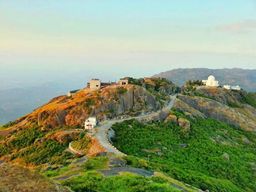




Arrive Udaipur and transfer to
your hotel. Set on the shores of Lake Pichola and surrounded by hills, Udaipur
grew in complete contrast to the harsh deserts of the rest of Rajasthan. As
capital of the old Mewar State it was the only Rajput stronghold to uphold its
Hindu allegiance in the face of Muslim invasion. This fairy – tale city, with
its marble palaces and lakes surrounded by a ring of hills, was founded by
Maharana Udai Singh in 1559. The city is dominated by massive City Palace,
which overlooks Lake Pichola with its romantic island palaces. Picturesque
havelis, ghats and temples line the lake front, with the lively bazaars of the
old walled city stretching behind them.
Later in the evening take a boat
ride – on direct payment on the 4 km long and 3 km wide Lake Pichola, which is
fringed with hills, palaces, havelis, ghats, embankments and temples and offers
spectacular views of the city. Visit the Jag Mandir Island with its exquisite
Gul Mahal Pavilion
Overnight at Hotel
After breakfast proceed for excursion to Chittorgarh; Chittorgarh,
said to have been originally built by Bhim, one of the Pandavas. Though
deserted now, impressive reminders of its grandeur still stand. See Rana
Kumbha’s palace and Fateh Prakash palace. Visit the 37 m high Jaya Stambh
(Tower of Victory) built by Rana Kumbha to commemorate his victory over Khiljis
of Malwa in 1440. Also see the 22 m high Keerti Stambh or Tower of Fame,
dedicated to Adinath and decorated with figures of various Jain tirthankars.
The entrance of the Chittorgarh is
highly attractive with seven huge entries, namely Bhairon Pol, Lakshman Pol,
Padan Pol, Hanuman Pol, Jorla Pol, Ganesh Pol and the main royal gate known as
Ram Pol. Major attractions in Chittorgarh include the amazing Chittorgarh fort,
Keerti Stambh, Victory tower or Vijay Stambh, Rani Padmini’s Palace, Rana
Kumbha’s Palace and many beautiful imposing temples of great past.
After arrival in Udaipur proceed
for half day city tour of Udaipur – visiting the City Palace and Museum. The
largest palace complex in India, it is a blend of Mughal and Rajput influences.
Also, see the 17th century Jagdish temple, drive around the Fatehsagar Lake,
and visit the Sahelion ki Bari (the Garden for the Maids of Honour), an
ornamental pleasure garden with fountains and marble kiosks. Later visit the
Bharatiya Lok Kala Mandir or the Folk-Art Museum.
After breakfast proceed for Kumbhalgarh,
is one of the finest examples of defensive fortifications in Rajasthan. The
15th century fort commands an important strategic position and gives superb
views over the surroundings. The 36 km long walls enclose palaces, gardens,
temples and water storage facilities. The fort is believed to have been taken
only once in its history. There is also a wildlife sanctuary here, known for
wolves. Other wildlife found here includes leopards, antelopes and sloth bears.
Overnight at Hotel
After breakfast drive to
Mount Abu enroute visiting Ranakpur – which is the largest Jain temple complex
in India and dates to the 15th century. The main temple is dedicated to
Adinath, the first Tirthankar. Intricate carvings detail mythological figures,
patterns and motifs on the walls, pillars and domes. There are 1444 ornately
carved marble pillars in the complex and none of them are similar. The
beautiful lace-like interiors of the domes are a superb example of western
Indian temple style. Surya temple and
other Jain temples are side attractions. (Temples open only at 1200 Hrs.
Leather belts, footwear, bare legs and black clothing not allowed)
Later continue to drive to Mount Abu; Arrive Mount Abu and transfer to
your hotel At 1200 meters, Mt. Abu is the highest point of the Aravalli Range
passing through Rajasthan. The only hill resort of Rajasthan, it is built
around a lake and is surrounded by forested hills. According to a legend, the
place derives its name from Arbuda, a serpent who descended to the spot to
rescue Shiva’s bull, Nandi. Besides having all the features of a pleasant hill
resort, Mount Abu is also a centre of pilgrimage for Jains on account of the
famous Dilwara Temples. There are interesting treks and picnic spots, romantic
royal retreats of various erstwhile royal families, and some relics of the Raj
period.
Visit the breath taking Dilwara
temples, among the finest examples of Jain architecture with their superb
marble carving. The complex consists of five temples built between the eleventh
and thirteenth century. The intricate ornamental carvings here represent the
great heights reached in stone decoration. Also visit Nakki Lake and see the
strange rock formations around it including Toad Rock. The Achalgarh fort has
the famous Achaleshwar temple and provides superb views of the area.
Overnight at Hotel